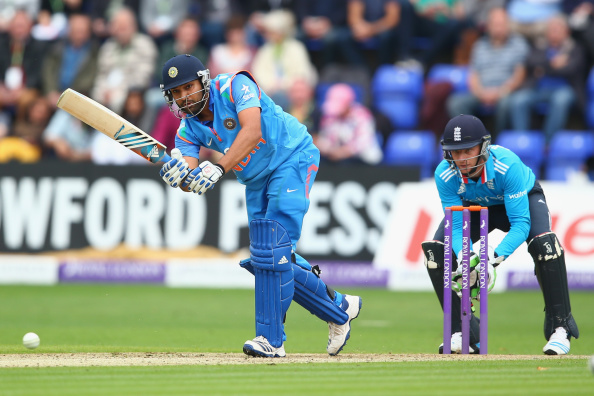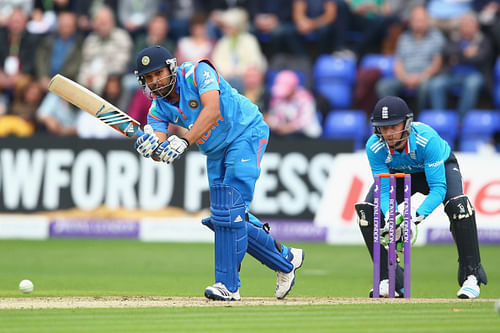
When Rohit Sharma went 'away' for ODIs

Only yesterday, I wrote an article on Rohit Sharma and his inadequacies in Test cricket, and came under heavy criticism from readers who thought I was unfair. Unfair because I didn’t consider his ODI scores to evaluate his Test performance, unfair because Rohit is talented, unfair because Virat Kohli hasn’t been criticized as much as Rohit has, unfair because well, um… once again, Rohit is talented.
So, I decided to delve into his ODI records and found them to be quite satisfactory. Two double hundreds, nearly four thousand runs, an average in the late thirties. So was I wrong?
Maybe I was wrong. In the age of simply glancing through IPL records & home-performances to judge a player’s caliber, I was almost criminal. As an apology, I thought I will present Rohit-backers, with an analysis of his ODI performances, considering how essential a cog Rohit is, in India’s World Cup plans. And considering that the World Cup is being played away from home, I thought what better than to delve into the away performances of Mr. Talent himself.
The reason I chose ‘Away’ is because of the age old saying that your quality as a player is determined only when you step out of your territory and do well abroad. This in fact, can be called the fundamental principle of my arguments, so let’s not challenge this, for now.
Rohit has been brilliant against the West Indies, in their home or in neutral territory; he has scored 430 runs, at an average of 53.75 and a strike-rate of nearly 80. After the West Indies, his next favourite opposition has been Zimbabwe, against whom he scored 226 runs at an average of 45.
But sadly enough, for better or for worse, performances against West Indies and Zimbabwe do not matter - they are No. 8 and No. 10 ranked teams in the ICC ODI rankings respectively, and I do not wish to dilute the standard of what is deemed to be a good performance.
Now let’s go further and see how he fares against the countries who figure in the Top 7 (alongside India) of the ICC ODI Rankings, when playing away from home.
Rohit's 'Away' ODI record versus Top 7 Nations
|
|
Innings |
Runs |
Average |
100/50 |
Strike Rate |
|
Australia |
9 |
192 |
24.00 |
0/1 |
71.37% |
|
England |
3 |
61 |
30.50 |
0/1 |
59.80% |
|
New Zealand |
7 |
192 |
32.00 |
0/1 |
66.89% |
|
Pakistan |
8 |
255 |
36.42 |
0/3 |
78.94% |
|
South Africa |
9 |
159 |
17.66 |
0/1 |
61.38% |
|
Sri Lanka |
33 |
692 |
26.61 |
1/3 |
73.85% |
Terrible Strike-rate for a top order batsman
Strike-rate as we all know, is the number of runs per hundred balls, and with the advent of T20 cricket, has become crucial for any team’s success in the limited overs format of the game. As an opener, or even a front line batsman, you are expected to have a high strike rate, as if you don’t, the burden of scoring shifts to other players leading to unnecessary pressure to score.
In case you are an opener, a healthy strike rate is necessary because it implies two things: first, that you are rotating the strike, second, that you are taking advantage of the new ball and field restrictions. A healthy strike rate doesn’t necessarily mean being an Afridi or a Sehwag, it means not getting bogged down.
The range in which Rohit Sharma’s scoring rate lies is 59.80 – 78.94, allowing his strike-rate away from home to be best described as mediocre. If we look deeper, we will notice that barring one nation, the majority of his strike rate hovers between 60-75 runs scored per hundred balls. When the average strike rate of his team (from the opener to the last man included) in a similar period is 81%, it is indeed substandard.
He has played as many as 69 innings away from home (versus the above mentioned teams), and scored only a solitary hundred against Sri Lanka. Furthermore, his half century count is also not very high, suggesting that he scores a half century once in every 7 innings.
Contrast this with Virat Kohli’s performances against the same six teams; you have a strike rate of nearly 87, 7 centuries and 12 half-centuries, in a somewhat similar 63 innings. I specifically brought up Kohli, because readers feel that Kohli isn’t sufficiently criticized, and also because I feel that Kohli sets a benchmark for performances to be evaluated in the Indian ODI setup.
Moving on to averages, Rohit fares poorly against Australia, South Africa and surprisingly, Sri Lanka (considered to provide similar batting conditions as home); his averages against Pakistan and New Zealand can be best described as mediocre, while the number of innings against England is too small a sample size for me to be passing a judgment on.
Australia one of Sharma’s least favourite countries to bat in
Considering that the majority of India’s matches during the World Cup ‘15 will be played in Australia, it would only be right to see how the team’s No. 1 opener has fared in Kangaroo territory
Between 2008 and 2012, Rohit Sharma has played as many as 15 games in Australia, with negligible returns. With no hundreds, two fifties and a highest of 70 not out that came in 2008; Rohit has scored 314 runs at an average of 26.16 only.
In this duration, he has been dismissed for zero twice, and has a strike-rate that touches 75. Out of the 12 dismissals, he has been given out caught by the wicket-keeper, 6 times, and the majority of those wickets have been claimed by pace bowlers. Like is the case with him in Test matches, he has mostly been dismissed between the score of 0 and 29.
If Indian cricket wants to leave its footprints beyond the highways of Rajkot and the batting-beauties of Bengaluru, it must take stock of what the reality is. It must stop convincing itself that performances in the IPL and the odd-show of brilliance against listless bowlers, in friendly conditions are the true bearings of a world-class player.
At the end of the day it’s about the legacy it wants to leave behind, and that legacy is always incomplete if Indian batsmen continue to remain Gods at home and lambs abroad.